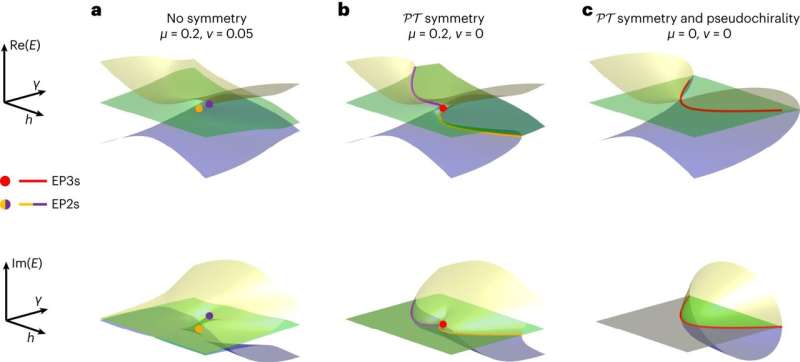This article has been reviewed according to Science X's editorial process and policies. Editors have highlighted the following attributes while ensuring the content's credibility:
fact-checked
peer-reviewed publication
proofread
Team observes third-order exceptional line in nitrogen-vacancy spin system

Researchers have systematically studied the relations between symmetries and high-order non-Hermitian exceptional points (EPs), and observed the third-order exceptional line (EL) in a nitrogen-vacancy (NV) spin system. The work is published in the journal Nature Nanotechnology.
EPs are singularities in non-Hermitian systems, where there are two or more eigenvalues and eigenstates coalesce. Many exotic topological phenomena and novel dynamic features occur thanks to the unique characteristics of EPs. EPs have played an essential role in understanding edge-cutting areas like quantum computing and topological phase transitions.
High-order EPs exhibit richer topological characteristics and better sensing performance than second-order EPs. However, realizing high-order EPs is rather difficult since it relies on the simultaneous tuning of multiple system parameters, and the higher the order of the EPs, the more system parameters must be tuned simultaneously, making the realization process challenging.
The research teams—led by Academician Du Jiangfeng and Prof. Rong Xing from CAS Key Laboratory of Microscale Magnetic Resonance of University of Science and Technology of China (USTC)—utilized a single NV center, an atomic-scale defect in diamond, and the nuclear spin system to realize the non-Hermitian systems that embrace both PT symmetry and pseudochirality. Furthermore, the experimental observation of third-order EL in two-dimensional parameter space was reported.
By systemically investigating the role of symmetry in high-order EP geometries, the researchers revealed that third-order EPs can exist as isolated points when there was only PT symmetry in the non-Hermitian Hamiltonian.
The researchers further explored the relationship between the third-order EPs and the symmetries of the non-Hermitian Hamiltonians. It turned out that there was no third-order EP when the non-Hermitian Hamiltonian had no symmetry, which highlights the importance of symmetries in studying the structure of high-order EPs.
It is worth mentioning that the successful observation of high-order EP geometries has benefited from the former studies in diamonds. Prof. Wang Ya, in particular, has been dedicated to synthesis and production of high-quality diamonds for many years, which has laid a solid foundation for this work.
This work is of fundamental importance to non-Hermitian studies. It can be further applied to explore high-order EP-related topological physics at the atomic scale and shed light on quantum control and quantum-enhanced metrology.
More information: Yang Wu et al, Third-order exceptional line in a nitrogen-vacancy spin system, Nature Nanotechnology (2024). DOI: 10.1038/s41565-023-01583-0
Journal information: Nature Nanotechnology
Provided by University of Science and Technology of China





















